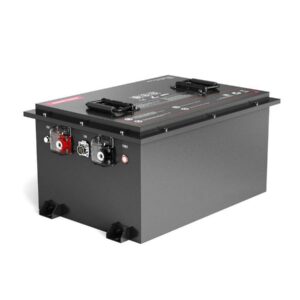
What is the best battery voltage for a diesel truck?
The optimal battery voltage for diesel trucks is typically 12V for standard models and 24V for heavy-duty applications. 12V systems dominate due to compatibility with starters requiring 800–1,500 cold cranking amps (CCA), while 24V setups reduce current draw in extreme loads. Lithium (LiFePO4) and AGM batteries are preferred for their high CCA ratings, vibration resistance, and dual-battery configuration stability.
What Is the Best Battery for a Diesel Pickup Truck?
Why is 12V standard for most diesel trucks?
12V balances starter motor demands (9–16V operating range) with accessory compatibility. Modern 12V AGM batteries deliver 1,000+ CCA while fitting factory trays. Heavy-duty alternators (150–220A) maintain stable charging even with winches or plows.

Practically speaking, 12V systems dominate because they align with global automotive standards. Starters in diesel trucks like Ford PowerStroke or Ram Cummins require 7.5–11 kW bursts, which 12V AGM/LiFePO4 packs efficiently deliver. Pro Tip: For sub-zero climates, prioritize CCA over capacity—a 1,000 CCA battery starts engines at -30°C, while 800 CCA models struggle. Consider this real-world scenario: A 2023 Silverado 2500 HD’s dual 12V 800 CCA AGM batteries provide redundancy—if one fails, the truck can still start using the backup.
When should diesel trucks use 24V battery systems?
24V systems suit military or mining trucks with extreme loads. By doubling voltage, they halve current for the same power, reducing cable thickness and heat in winches/PTOs.
Beyond heavy machinery, 24V excels in custom builds with high-power auxiliaries. For instance, a firetruck running a 20kW hydraulic pump needs 24V to avoid 1,000A+ currents that melt 12V wiring. Technically, 24V batteries use two 12V units in series, but dedicated 24V LiFePO4 packs (like Dragonfly Energy’s 24V 200Ah) save space. However, converting a 12V truck to 24V requires replacing the alternator, starter, and all electronics—a $3,000+ investment. Pro Tip: Use voltage step-down converters (24V→12V) for accessories like radios or GPS to avoid rewiring.
| Factor | 12V System | 24V System |
|---|---|---|
| Starter Current | 400–1,200A | 200–600A |
| Cable Cost | $2.50/ft (2/0 AWG) | $1.50/ft (4 AWG) |
| Common Applications | Pickups, RVs | Military, industrial |
AGM vs. Lithium: Which battery type performs best?
AGM batteries lead in affordability ($200–$300) and temperature resilience (-40°C to 65°C). Lithium (LiFePO4) offers 3× longer cycle life (3,000 vs. 1,000 cycles) and 50% weight reduction.
AGM’s absorbed glass mat design resists vibration—a key advantage for off-road diesel trucks. But what happens when you need rapid recharging? Lithium accepts 100A+ charging currents, refueling in 2 hours versus AGM’s 6–8 hours. For example, a Freightliner Cascadia with LiFePO4 can recharge during a 30-minute break using a 150A DC-DC charger. Pro Tip: Install a battery heater ($120–$200) for lithium in cold climates—it prevents charging damage below 0°C.
| Metric | AGM | LiFePO4 |
|---|---|---|
| Cost per Cycle | $0.20 | $0.10 |
| Weight (100Ah) | 60–70 lbs | 25–30 lbs |
| Peak Discharge | 5C (500A) | 10C (1,000A) |
Are Duracell Car Batteries a Good Choice for Your Vehicle?
How do cold cranking amps (CCA) affect diesel starts?
CCA measures a battery’s 30-second power at -18°C. Diesel trucks need 20–50% higher CCA than gas engines due to compression ratios (16:1 vs 10:1).
Take a 6.7L PowerStroke engine: It requires 950 CCA minimum, but experienced owners recommend 1,150 CCA for -30°C reliability. Paradoxically, lithium batteries often list “MCA” (marine cranking amps) at 32°C—multiply by 0.8 to estimate CCA. Pro Tip: Test battery voltage after 15 seconds of cranking—if it drops below 9.6V (12V system), replace the battery immediately.
What maintenance extends diesel truck battery life?
Monthly terminal cleaning (baking soda + water) prevents corrosion. For AGM, check electrolyte levels biannually; lithium needs state-of-charge (SOC) kept above 20%.
Beyond basic care, use a desulfator ($50–$150) for AGM batteries to break down lead sulfate crystals. For dual-battery setups, install an isolator ($80–$300) to prevent accessory drain from killing the starter battery. Imagine a plow truck idling for hours—the isolator ensures only the secondary battery powers the hydraulics. Pro Tip: Every 6 months, load test batteries—a 50% SOC AGM should hold 12.4V under 50% CCA load for 15 seconds.
Battery Expert Insight
FAQs
Can I use a 24V battery in a 12V diesel truck?
No—24V will fry 12V electronics. Use a 12V→24V step-up converter only for specific high-power accessories, not the entire vehicle.
What happens if my battery voltage drops to 10V?
Immediate replacement is needed—sulfation permanently damages lead plates, reducing capacity by 30–60%.
How long do diesel truck batteries last?
AGM: 3–5 years; Lithium: 8–12 years. Short trips (under 15 minutes) accelerate AGM degradation by 40% due to incomplete charging.
